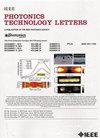P-Metal Geometry Impacts Micro-LEDs Efficiency: Current Spreading and Light Extraction
IF 2.3
3区 工程技术
Q2 ENGINEERING, ELECTRICAL & ELECTRONIC
引用次数: 0
Abstract
P-metal geometry has a significant impact on chip current spreading, which, in turn, affects the optoelectronic characteristics of the devices. We designed and fabricated a series ofp金属几何形状对微型led效率的影响:电流扩散和光提取
p金属几何形状对芯片电流扩展有显著影响,进而影响器件的光电特性。我们设计并制造了一系列价值37~\mu $ m平方的微型led绿色芯片,它们具有不同的p金属几何形状(环形、圆盘形和十字形),并随后研究了它们的光电特性。结果表明,当p金属呈十字形时,其光电特性达到最佳,外量子效率高达18.85%。与环形p金属和圆盘p金属相比,这分别提高了12.20%和3.52%。分析表明,这是因为十字形p金属结构更适合方形台面,导致芯片电流更均匀地扩散。利用COMSOL和TracePro模拟分析了不同p金属几何形状芯片的电流扩散和光输出,并验证了我们的假设。该研究在微型led芯片的设计和制造方面具有重要意义。
本文章由计算机程序翻译,如有差异,请以英文原文为准。
求助全文
约1分钟内获得全文
求助全文
来源期刊

IEEE Photonics Technology Letters
工程技术-工程:电子与电气
CiteScore
5.00
自引率
3.80%
发文量
404
审稿时长
2.0 months
期刊介绍:
IEEE Photonics Technology Letters addresses all aspects of the IEEE Photonics Society Constitutional Field of Interest with emphasis on photonic/lightwave components and applications, laser physics and systems and laser/electro-optics technology. Examples of subject areas for the above areas of concentration are integrated optic and optoelectronic devices, high-power laser arrays (e.g. diode, CO2), free electron lasers, solid, state lasers, laser materials'' interactions and femtosecond laser techniques. The letters journal publishes engineering, applied physics and physics oriented papers. Emphasis is on rapid publication of timely manuscripts. A goal is to provide a focal point of quality engineering-oriented papers in the electro-optics field not found in other rapid-publication journals.
 求助内容:
求助内容: 应助结果提醒方式:
应助结果提醒方式:


